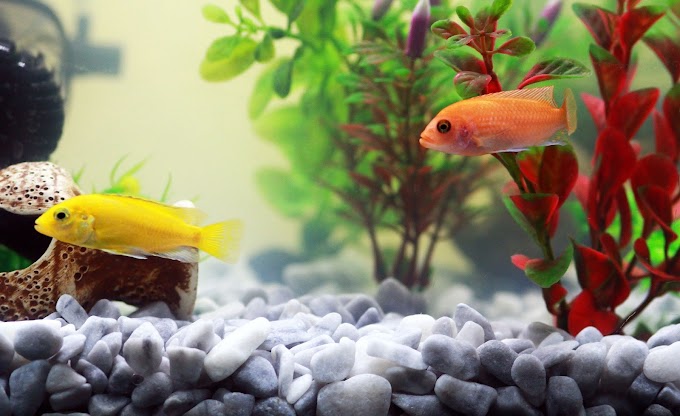 |
| Photo by Daniel Corneschi on Unsplash |
The key to keeping your fish healthy and happy is knowing what they're saying with their behavior.
Though you'll not spend much time twiddling with your fish, it's important to know their behavior, a bit like any pet.
The way your fish is acting can tell you if he's healthy or sick, if the aquarium water is correctly maintained or not.
Here are some common fish behaviors that you may observed:
Hiding Fish:
Hiding is totally natural behavior for many fish, especially once they are first introduced to their new aquarium.
Just confirm you retain your fish comfortable
and healthy, and he should start beginning of hiding more readily.
Fighting Fish:
If your fish are fighting, it generally means they're not a compatible fit be housed within the same aquarium.
Many fish are naturally aggressive and can defend their territory to the death.
Before stocking your aquarium, you need to
do research on which kinds of fish are compatible with others together.
 |
| Photo by Fernando Maté on Unsplash |
Here are some
recommendations on keeping a peaceful aquarium:
• confirm your
aquarium is large enough to accommodate all of your fish.
• Make sure
there are many hiding spaces in your tank for more submissive fish.
• Change the
scenery periodically and always before adding new fish, so eliminate
territorial claims and competition.
• Have an honest
sort of differing types of fish.
Fish Swimming Erratically:
If your fish is swimming erratically or straightly on upward side, he could just be playing or exercising.
If your fish does it this consistently and seems unhealthy, the cause could also be poor water quality.
You ought to test your water for pH, ammonia, and nitrates immediately to ascertain if anything is improper and harming your fish.
If everything is so as, the explanation for your fish’s erratic behavior may might be a parasite.
If your fish is
rubbing himself up against something within the tank, then swimming quickly
away, he may have an external parasite.
 |
| Photo by Craig Lovelidge on Unsplash |
Listlessness:
If your fish seem tired and lethargic, it are often as a results of many factors.
One common cause is improper water temperature. If your fish’s water is just too hot or too cold, they're going to be very inactive.
Check your heater and verify that your aquarium is at the proper level.
Other possible factors are
overfeeding and improper water quality.
Sitting on the Bottom:
If your fish is spending many time at rock bottom of the tank, it's going to be normal behavior.
Many fish, like catfish, are bottom-feeders and spend their time at bottom.
Fish also often sleep at rock bottom of their tank.
If your fish’s activity, however, doesn't seem to suit either of those reasons, and he looks tired and listless at rock bottom of the tank, it's going to be a symbol of disease.
 |
| Photo by kazuend on Unsplash |
If you think that this is often the case, you ought to quarantine the fish. a standard disease which may cause this behavior could also be a swim bladder infection, which can be a results of a poor diet or water quality.
Try fasting your fish for each day or two or feeding it
easy-to-digest foods like peas.
Gasping for Air:
Fish may see gasping for air at top of the aquarium and it are often thanks to improper water quality or thanks to insufficient dissolved oxygen within the water.
Testing your water and considering an aerator for your aquarium will solve the matter.
Reproductive
Behaviour:
Gonadal hormones are liable for the regulation of reproductive behaviour of male and female fishes.
There are phases within the breeding cycle which describes beahaviors of fishes
like pre spawning, spawning, and post spawning behaviours of males and females
fishes.
Swimming
Behaviour:
Some species of fish, particularly cyprinids like barbs and loaches, spawn in groups during the spawning process, it isn't uncommon for the male of the group to be seen chasing the female around the tank.
While swimming quickly around the tank, the female typically releases her burden of eggs, scattering them across the substrate, while the male releases his sperm, fertilizing the eggs as he passes by.
 |
| Photo by Maksym Sirman on Unsplash |
Watch your fish closely for a flash or two to work out whether or not their erratic behavior could be thanks to spawning.
If it is, you've got nothing to
stress about your fish should return to normal after they finish spawning.
Feeding Behavior:
Several
molecules stimulate both smell and taste organs, but behavioral responses to
those stimuli are often very different.
Searching Behavior:
Food density requirements are estimated from behavioral search models.
These models in their simplest form require an estimate of ration, swimming speed, perceptive field, and feeding success with many other parameters added as complexity increases.
Searching abilities increase markedly with growth, since speed,
capture success rates, and perceptive distances are functions of length or age.
Fighting Among
Tank Mates:
If you propose to stay a community tank, you ought to be prepared to experience some fighting among the fish in your tank at one point or another, especially if you propose to combine community species with semi-aggressive species of fish.
Some species are naturally more aggressive and territorial than others and, if they are doing not have adequate space within the tank or if they feel that their perceived territory is being threatened, they'll antagonize their tank mates.
The primary step in handling this problem is to make sure that your tank is large enough if your tank is overcrowded, there's little you'll do apart from upgrading to a bigger tank or removing a number of the fish.
 |
| Photo by Daniel Corneschi on Unsplash |
Another trick you would possibly try is to feature some more live plants or decorations to supply hiding places and to interrupt up the road of check in your tank this might help to place aggressive fish comfortable.
you ought to even be sure that you simply don't keep quite one male of semi-aggressive species like Gouramis within the same tank even fish that are typically peaceful may become aggressive and territorial within the presence of rival males.
If you've got schooling species
in your tank, like barbs or tetras, confirm you've got a minimum of 5 or 6 of
every species within the school this may help to scale back non
species-specific aggression.
Protective Behaviors:
There are variety of probably useful strategies which a fish might adopt to realize protection against predators during the amount of adjustment.
These include freezing, hiding, seeking the corporate of other fish, and counter attack.
 |
| Photo by Fernando Maté on Unsplash |
The opposite responses are far more typical.
Perce flavescent dive but will remain motionless at rock bottom corners of a pail, few satisfactory topographic point.
Bluegills, don't even seek rock bottom but will stay during a corner with contact on all sides of the top.
Variety of fish like the flounders are ready
to bury themselves very quickly in sand.







0 Comments